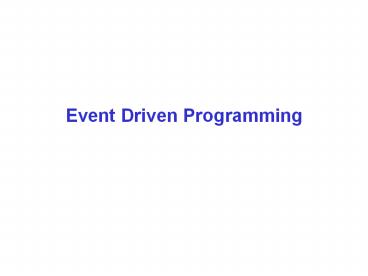Event Driven Programming - PowerPoint PPT Presentation
Title:
Event Driven Programming
Description:
... you used with your Mom and Dad when you were little and went on ... Eventually your Dad said something like, 'I'll tell you when we get there, sweetie. ... – PowerPoint PPT presentation
Number of Views:152
Avg rating:3.0/5.0
Title: Event Driven Programming
1
Event Driven Programming
2
Event-driven Programming
- In the early days of computing communication with
the outside world was accomplished using a
technique called Polling. - This is the technique you used with your Mom and
Dad when you were little and went on a long trip - Are we there yet?
- Are we there yet?
- Are we there yet?
- Are we there yet?
- Are we there yet?
- Are we there yet?
3
Event-driven Programming
- Eventually your Dad said something like, Ill
tell you when we get there, sweetie. - In a like manner early programs would check the
keyboard to find out if a key had been pressed
and then take action. - As the user interface (keyboard, mouse, screen)
became more complex this became problematic. - There was simply too much activity to keep track
of what was going on efficiently.
4
Event-driven Programming
- So a system was developed where some very
fast-efficient code is included as either part of
the operating system or the JVM - In this approach the programmer can say when a
certain event occurs a certain piece of code
should be executed - This is refined and expanded with modern
languages by providing programmers with a
Graphical User Interface Toolkit - This means that items (referred to as widgets)
are pre-programmed in to the system. These
include buttons, text areas, etc.
5
Event-driven Programming
- Programmers now have tools to design screen
layouts and make them respond as desired. - Today we will show you a small demo and the code
that runs it.
6
Adding Machine
- We want a small window that will display
- Two editable numbers
- One non-editable sum
- An ADD Button
- A Clear Button
7
How it works
Unlike the other programs you have written
event-driven programming doesnt follow a single
path
The functionality of the text windows is built-in
Different objects will be constructed to handle
the action when each button is pressed
8
The Code
- import java.awt.event.
- import javax.swing.
- import java.awt.
- class Adder extends WindowAdapter
- // The widget references
- public JFrame f
- public JPanel p
- public JTextField top
- public JTextField bottom
- public JTextField sum
- public JButton add
- public JButton clear
9
The Code
- // Constructor
- public Adder()
- // Top level window on screen
- f new JFrame("Adding Machine")
- f.setSize(200, 200)
- // Panel to hold components
- p new JPanel()
- // 3 text fields to hold 2 numbers and
sum - top new JTextField("0.0", 20)
- top.setHorizontalAlignment(JTextField.RIGH
T) - bottom new JTextField("0.0", 20)
10
The Code
- // Still in constructor
- bottom.setHorizontalAlignment
-
(JTextField.RIGHT) - sum new JTextField("0.0", 20)
- sum.setHorizontalAlignment(JTextField.RIGH
T) - sum.setEditable(false)
- // Add and clear buttons
- add new JButton("ADD")
- add.addActionListener(new
- AddButtonHandler(top, bottom,
sum)) - clear new JButton("CLEAR")
- clear.addActionListener(new
- ClearButtonHandler(top, bottom,
sum))
11
The Code
- // Still in constructor
- // How it looks
- p.setLayout
- (new BoxLayout(p,
BoxLayout.Y_AXIS)) - f.getContentPane().add(p)
- p.add(top)
- p.add(bottom)
- p.add(sum)
- p.add(add)
- p.add(clear)
- f.addWindowListener(this)
- f.show()
12
The Code
- // Handle clicking on window close X
- public void windowClosing(WindowEvent e)
- System.exit(0)
- // Start it up
- public static void main(String args)
- new Adder()
13
Event Handlers
- import java.awt.event.
- import javax.swing.
- import java.awt.
- class ClearButtonHandler implements
ActionListener - // Widgets
- JTextField top, bottom, sum
- // Constructor
- public ClearButtonHandler(JTextField top,
- JTextField bottom,
- JTextField sum)
- this.top top
- this.bottom bottom
- this.sum sum
14
Event Handlers
- import java.awt.event.
- import javax.swing.
- import java.awt.
- // Clear all the text fields
- public void actionPerformed(ActionEvent e)
- top.setText("0.0")
- bottom.setText("0.0")
- sum.setText("0.0")
15
Event Handlers
- import java.awt.event.
- import javax.swing.
- import java.awt.
- class AddButtonHandler implements ActionListener
- // Widget References
- JTextField top, bottom, sum
- // Constructor
- public AddButtonHandler(JTextField top,
- JTextField bottom,
- JTextField sum)
- this.top top
- this.bottom bottom
- this.sum sum
16
Event Handlers
- // Get text field contents, convert, add and
disp - public void actionPerformed(ActionEvent e)
- double t, b, total
- String tString top.getText()
- String bString bottom.getText()
- try
- t Double.parseDouble(tString)
- catch(Exception e1)
- t 0.0
- top.setText("Error!")
17
Event Handlers
- try
- b Double.parseDouble(bString)
- catch(Exception e2)
- b 0.0
- bottom.setText("Error!")
- total t b
- sum.setText((new Double(total)).toString()
)
18
(No Transcript)































